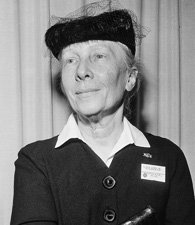Lillian Moller Gilbreth fought the social conventions of her time to become one of the first PhD-holding female engineers. She was also a psychologist and penned several books, including the groundbreaking industrial workplace relations work “The Psychology of Management.” In addition to her career, she raised 12 children, a story told in the children’s books “Cheaper by the Dozen” and “Belles on Their Toes.”
Lillian Moller Gilbreth’s Early Days
Lillian Evelyn Moller was born on May 24, 1878, in Oakland, Calif. A top student in high school, Gilbreth wanted to go to college, but her father did not support the idea. Despite that, she earned her bachelor’s in literature from the University of California at Berkeley and spoke at her graduation ceremony in 1900, becoming the first woman at the University of California to do so.
She headed off to New York’s Columbia University for grad school, but returned home due to illness. She went on to get a master’s in literature from Berkeley in 1902, after which she went to Boston for vacation. There, she met construction company owner Frank Gilbreth, who was eager to share his love for workplace efficiency with her. The two—and the concepts of industrial psychology—struck a chord, and three weeks after Lillian Moller returned from a trip to Europe, he proposed.
Sources in this Story
- San Diego Supercomputer Center: Lillian Moller Gilbreth
- Encyclopedia Britannica: Lillian Evelyn Gilbreth
- Project Gutenberg: The Psychology of Management by Lillian Moller Gilbreth
- Brown Alumni Magazine: Industrial Engineering
- New York Times: Ernestine Gilbreth Carey, 98, Author of Childhood Memoir, Dies
- National Women’s Hall of Fame: Lillian Moller Gilbreth
Gilbreth’s Work in Engineering and Psychology
The Gilbreths married in 1904, and the couple began a workplace efficiency consultancy. In 1911, they released the research paper “Motion Study,” the first of many works on their theory of “time and motion study,” which established a method for calculating the number of movements and time necessary for workers to complete a given task.
Meanwhile, Lillian Gilbreth prepped for her doctorate degree in psychology, researching potential theories of workplace efficiency. She had worked toward a PhD at Berkeley, including writing a dissertation entitled “The Psychology of Management,” which to this day is considered a groundbreaking work on the topic.
The couple moved to Rhode Island during the early 1910s. She graduated with her doctorate in psychology from Brown University in 1915. By that point she was the parent of four children; Gilbreth became the first mother to earn a PhD from the Ivy League institution.
The Gilbreths continued their research in industrial psychology. Lillian Gilbreth concentrated on the emotional aspects of employee treatment, namely how to make employees feel valued and put them in positions they find inspiring, as well as what constitutes a high-quality manager.
Gilbreth also used motion study to adapt workplace procedures for the disabled, and was a consultant to the Institute of Rehabilitation Medicine. She was an adviser to several presidents, including Herbert Hoover, serving on his Emergency Committee for Unemployment Relief; Franklin D. Roosevelt, as part of his Office of War Information during World War II; Dwight D. Eisenhower; John F. Kennedy and Lyndon B. Johnson.
She was also a professor at Purdue University, Newark College of Engineering and the University of Wisconsin. On top of all of this, she also did private sector consulting for several companies, including General Electric, where she advised on kitchen supply manufacturing.
The Woman and Her Work
- “The Psychology of Management” by Lillian Moller Gilbreth
- “Belles on Their Toes” by Frank B. Gilbreth Jr. and Ernestine Gilbreth Carey
- “Making Time: Lillian Moller Gilbreth—A Life Beyond ‘Cheaper by the Dozen’” by Jane Lancaster
The Rest of the Story
The Gilbreths had 12 children—six girls and six boys—in 17 years; Frank died in 1924, the day after Ernestine Gilbreth Carey graduated from high school. But thankfully, the Gilbreths had already introduced their workplace theories into the home. Lillian Gilbreth was able to continue working because she effectively had her children manage themselves and one another.
Two of Gilbreth’s children, Ernestine Gilbreth Carey and her younger brother Frank B. Gilbreth, Jr., chronicled their efficient, streamlined childhood in the now-classic children’s book “Cheaper by the Dozen” and its sequel, “Belles on Their Toes.” In it they described their home as “organized confusion” and compared it to “a newspaper on election night,” according to The New York Times. The family matriarch also wrote her own books on effective domestic management, “The Home-Maker” and “Her Job and Management in the Home.”
Her ability to juggle the myriad tasks associated with her work and home life led her to California Monthly magazine dubbing her, “a genius in the art of living,” in 1944. Later in her life, she was named to the Society of Industrial Engineers as an honorary member, as it did not admit women at the time. In 1966, she became the first woman to receive the Hoover Medal for public service in engineering.
Gilbreth continued to work until age 90; she died two years later on January 2, 1972.
This article was originally written by Anne Szustek; it was updated April 28, 2017.











